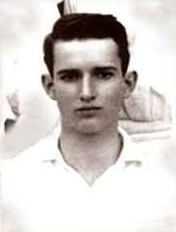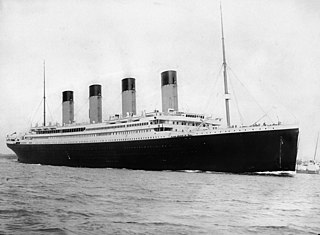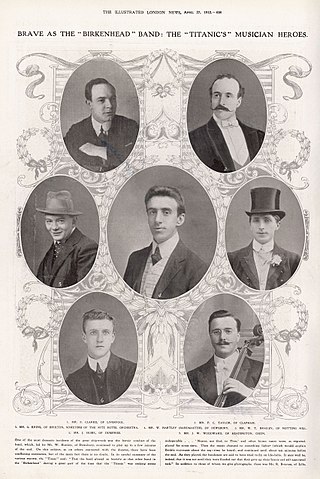Related Research Articles

Violet Constance Jessop was an Irish-Argentine ocean liner stewardess and Voluntary Aid Detachment nurse in the early 20th century. Jessop is best known for having survived the sinking of both RMS Titanic in 1912 and her sister ship HMHS Britannic in 1916, as well as having been aboard the eldest of the three sister ships, RMS Olympic, when it collided with the British warship HMS Hawke in 1911.

Wallace Henry Hartley was an English violinist and bandleader on the Titanic during its maiden voyage. He became famous for leading the eight-member band as the ship sank on 15 April 1912. He and the rest of the band did not survive the sinking.

Sir Arthur Henry Rostron, KBE, RD was a British merchant seaman and a seagoing officer for the Cunard Line. He is best known as the captain of the ocean liner RMS Carpathia, when it rescued the survivors from the RMS Titanic after the ship sank in 1912 in the middle of the North Atlantic Ocean.

The Titanic has played a prominent role in popular culture since her sinking in 1912, with the loss of almost 1,500 of the 2,224 lives on board. The disaster and the Titanic herself have been objects of public fascination for many years. They have inspired numerous books, plays, films, songs, poems, and works of art. The story has been interpreted in many overlapping ways, including as a symbol of technological hubris, as basis for fail-safe improvements, as a classic disaster tale, as an indictment of the class divisions of the time, and as romantic tragedies with personal heroism. It has inspired many moral, social and political metaphors and is regularly invoked as a cautionary tale of the limitations of modernity and ambition.
Frank "Lucky" Tower is the subject of an urban legend that said that he was a stoker who survived the sinking of RMS Titanic, RMS Empress of Ireland, and RMS Lusitania. There is no evidence that anyone was involved in all three disasters, and there was no one with the name of Frank Tower on the crew list on any of these vessels' respective voyages; however, there was one survivor and passenger named Frank Tower from Lusitania, and a William Clark who survived both the Titanic and Empress of Ireland sinkings.

John Borland "Jack" Thayer III was a first-class passenger on RMS Titanic who survived the ship's sinking. Aged 17 at the time, he was one of only a handful of passengers to survive jumping into the frigid ocean. He later wrote and privately published his recollection of the sinking.

RMS Titanic sank on 15 April 1912 in the North Atlantic Ocean. The largest ocean liner in service at the time, Titanic was four days into her maiden voyage from Southampton, England, to New York City, with an estimated 2,224 people on board when she struck an iceberg at 23:40 on 14 April. She sank two hours and forty minutes later at 02:20 ship's time on 15 April resulted in the deaths of more than 1,500 people, making it one of the deadliest peacetime maritime disasters in history.

The crew of the RMS Titanic were among the estimated 2,240 people who sailed on the maiden voyage of the second of the White Star Line's Olympic-class ocean liners, from Southampton, England, to New York City in the United States. Halfway through the voyage, the ship struck an iceberg and sank in the early morning of 15 April 1912, resulting in the deaths of over 1,500 people, including approximately 688 crew members.

RMS Titanic was a British ocean liner that sank in the early hours of 15 April 1912 as a result of striking an iceberg on her maiden voyage from Southampton, England, to New York City, United States. It was the second time White Star Line had lost a ship on its maiden voyage, the first being the RMS Tayleur in 1854. Of the estimated 2,224 passengers and crew aboard, approximately 1,500 died, making the incident one of the deadliest peacetime sinkings of a single ship. Titanic, operated by the White Star Line, carried some of the wealthiest people in the world, as well as hundreds of emigrants from the British Isles, Scandinavia, and elsewhere in Europe who were seeking a new life in the United States and Canada. The disaster drew public attention, spurred major changes in maritime safety regulations, and inspired a lasting legacy in popular culture.
Titanic was an ocean liner that struck an iceberg and sank in the North Atlantic Ocean in 1912.

The TitanicMusicians' Memorial is a memorial in Southampton, United Kingdom, to the musicians who died in the RMS Titanic disaster on 15 April 1912. The original Titanic Musicians' Memorial was unveiled by the Mayor of Southampton, H Bowyer on 19 April 1913, and was located in the old Southampton library. This library along with the memorial were destroyed during World War II. A replica was erected in 1990. The plaque features a musical inscription, the opening bars of the 19th century hymn, 'Nearer, My God, to Thee' by Sarah Flower Adams, carvings showing a grieving woman and an iceberg, and an inscription with the names of the musicians on the Titanic, including bandleader Wallace Hartley, all of whom died.
And the band played on is an expression used to describe the deliberate masking or downplaying of an impending calamity by authorities, often attributed in reference to the band that played during the sinking of the Titanic.

There have been several legends and myths surrounding the RMS Titanic and its destruction after colliding with an iceberg in the Atlantic Ocean. These have ranged from stories involving the myth about the ship having been described as "unsinkable" to the myth concerning the final song played by the ship's musicians.

The sinking of the RMS Titanic on April 14–15, 1912 resulted in an inquiry by a subcommittee of the Commerce Committee of the United States Senate, chaired by Senator William Alden Smith. The hearings began in New York on April 19, 1912, later moving to Washington, D.C., concluding on May 25, 1912 with a return visit to New York.

The musicians of the Titanic were an octet orchestra who performed chamber music in the first class section aboard the ship.

Marian Longstreth Thayer was an American socialite and survivor of the sinking of the RMS Titanic. She was the wife of John Borland Thayer II, a Director and Second Vice President of the Pennsylvania Railroad Company, and the mother of John Borland "Jack" Thayer III. In 1912, all three of them, along with their maid Margaret Fleming, were passengers on RMS Titanic maiden voyage when it struck an iceberg and sank. Marian, Jack III, and Fleming all survived, but John II died.

Titanic 2020 is the first novel of the Titanic 2020 series by Northern Irish author, Colin Bateman, published on 19 July 2007 through Hodder Children's Books.
The ocean liner Titanic has been extensively portrayed in films, books, memorials and museums.

John Wesley Woodward was an English musician. Born in West Bromwich on 11 September 1879, he was the youngest of ten children born to Joseph and Martha Woodward.

Frederick William Barrett was a British stoker. After having served as a stoker on several ships, on 6 April 1912, he was hired on board the RMS Titanic as lead stoker. On April 15, 1912, while the ship was sinking, Barrett boarded lifeboat No. 13 and took command of it, thus surviving the disaster. He later testified before commissions of inquiry into the sinking of the ship and continued to work in the navy until the 1920s. In 1923, after losing his wife Mary Anne Jones, he remained in Liverpool and worked ashore as a logger.
References
- 1 2 "Christopher Ward, Esq Authorised Biography". Debrett's People of Today Online. Debrett's . Retrieved 21 May 2012.
- 1 2 Greenslade, Roy (2004). Press Gang: How Newspapers Make Profits from Propaganda. London: Pan Macmillan. p. 402. ISBN 9780330393768.
- ↑ "Christopher Ward, 1995" (PDF). Mark Boxer Award - The 'Gong' for Outstanding Services to the Industry. British Society of Magazine Publishers. Archived from the original (PDF) on 3 June 2013. Retrieved 21 May 2012.
- ↑ "Media Lifeline: Redwood Publishing". Campaign . 21 November 2008. Retrieved 21 May 2012.
- ↑ "Unwavering commitment". World Wide Fund for Nature. Archived from the original on 24 December 2012. Retrieved 21 May 2012.
- ↑ Devan, Subhadra (30 March 2012). "That sinking feeling". New Straits Times . Archived from the original on 22 May 2012. Retrieved 22 May 2012.
- ↑ Ward, Christopher (29 February 2012). "What Happened To My Grandfather After the Titanic Sank". Huffington Post . Retrieved 22 May 2012.
- ↑ Davenport-Hines, Richard (20 August 2011). "Book reviews: When the great ship went down". The Spectator . Archived from the original on 5 May 2013. Retrieved 22 May 2012.